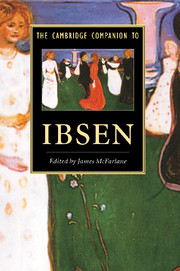Book contents
- Frontmatter
- 1 Ibsen's dramatic apprenticeship
- 2 Ibsen and historical drama
- 3 Dramatic and non-dramatic poetry
- 4 Ibsen and comedy
- 5 Ibsen and the realistic problem drama
- 6 Ibsen and feminism
- 7 The middle plays
- 8 The last plays
- 9 Ibsen's working methods
- 10 Ibsen and the theatre 1877-1900
- 11 Ibsen and the twentieth-century stage
- 12 Ibsen on film and television
- 13 On staging Ibsen
- 14 Ibsen and the drama of today
- 15 A century of Ibsen criticism
- 16 Works of reference
- Index
3 - Dramatic and non-dramatic poetry
Published online by Cambridge University Press: 28 May 2006
- Frontmatter
- 1 Ibsen's dramatic apprenticeship
- 2 Ibsen and historical drama
- 3 Dramatic and non-dramatic poetry
- 4 Ibsen and comedy
- 5 Ibsen and the realistic problem drama
- 6 Ibsen and feminism
- 7 The middle plays
- 8 The last plays
- 9 Ibsen's working methods
- 10 Ibsen and the theatre 1877-1900
- 11 Ibsen and the twentieth-century stage
- 12 Ibsen on film and television
- 13 On staging Ibsen
- 14 Ibsen and the drama of today
- 15 A century of Ibsen criticism
- 16 Works of reference
- Index
Summary
Brand is a work that has invited terms of discontinuity. It was Ibsen's response to what Halvdan Koht called the volcanic events of the year 1864, an eruption of bitterness over the death of his National-Romantic illusions about a modern Scandinavian brotherhood to match the heroic past. Georg Brandes, Ibsen's Danish critic and ally, referred to 'a shocking, yes overwhelming, impression of having come face to face with a strong and indignant genius, before whose penetrating gaze weakness feels constrained to lower its eyes'. Bjorn Hemmer has identified it as a milestone in Scandinavian literature, leading away from the current aesthetic and idealistic tendency into new fields, committed and contemporary; Brand became, and has remained, the most powerful drama of ideas in the whole of Scandinavian literature. And it is primarily by the ideas that criticism has been at once inspired and divided.
Brand has been taken to be a Christian and an anti-Christian work; the enactment of a specifically theological debate between Old and New Testament concepts of divinity; the story of an individual fighting an existential battle to define his own religious identity; a celebration and an expose of idealism, secular or religious. It has been derived, for approval or blame, from different philosophical systems - Kierkegaard, Hegel, Nietzsche - and related to mythic patterns of universal extent. Brand has been seen as both a vindication of Romanticism and its indictment; or, more recently, as the victim of psychological or socio-psychological conditioning. The ambivalence concentrates, finally, on the meaning of the last scene; does it imply Brand's acceptance or rejection, and in what terms?
- Type
- Chapter
- Information
- The Cambridge Companion to Ibsen , pp. 28 - 57Publisher: Cambridge University PressPrint publication year: 1994
- 1
- Cited by



